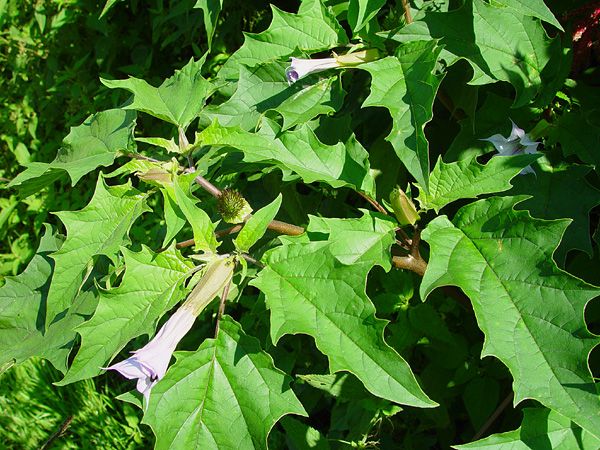Datura stramonium, also known as thorn apple, jimsonweed, devil’s trumpet, or datura, is a plant that has fascinated and alarmed people for centuries. Its striking appearance and potent effects make it a subject of interest in botany, traditional medicine, and even folklore. However, its toxic nature demands careful handling and respect.

Botanical Overview
Datura stramonium is a member of the nightshade family (Solanaceae), which includes plants like tomatoes, potatoes, and deadly nightshade. Native to the Americas, it has spread globally, thriving in a variety of environments, especially in disturbed soils such as roadsides, pastures, and waste grounds.
Key Features:
Height: Up to 1.5-2 meters.
Leaves: Broad, dark green, with irregular lobes.
Flowers: Trumpet-shaped, often white or pale purple, with a sweet but heavy fragrance. They bloom at night.
Seed Pods: Spiny, oval capsules that split open when mature, releasing numerous small, black seeds.
Chemical Composition and Effects
Datura stramonium contains several potent alkaloids:
Atropine
Scopolamine
Hyoscyamine
These compounds act on the central and peripheral nervous systems. They block the neurotransmitter acetylcholine, leading to a variety of effects ranging from mild sedation to severe hallucinations and delirium.
Historical and Cultural Uses
Datura stramonium has a long history of use in various cultures for its medicinal and psychoactive properties.
Health Risks of Datura Stramonium:
While Datura Stramonium may be visually appealing, it contains potent alkaloids such as atropine, scopolamine, and hyoscyamine, which are highly toxic to humans and animals. Ingesting any part of the plant, including the leaves, flowers, seeds, or roots, can lead to a range of symptoms, including hallucinations, delirium, rapid heartbeat, blurred vision, dry mouth, difficulty swallowing, and even coma or death in severe cases.
Accidental Poisonings and Concerns:
Despite its toxicity, Datura Stramonium is sometimes grown in gardens for its ornamental value, and its seeds are also occasionally used in traditional medicine or as a recreational drug due to their hallucinogenic properties. However, this poses a significant risk, especially in households with children or pets who may unknowingly come into contact with the plant.
Prevention and Management:
To prevent accidental poisonings, it is essential for gardeners to familiarize themselves with the characteristics of Datura Stramonium and to exercise caution when handling or disposing of it. If you suspect that you or someone else has ingested or come into contact with Datura Stramonium, seek medical attention immediately. In cases of poisoning, prompt treatment is crucial for a successful outcome.
While Datura Stramonium may be visually striking, its potential toxicity makes it a plant best avoided in gardens and landscapes, especially in environments where children or pets are present. By being aware of the risks associated with this plant and taking appropriate precautions, gardeners can help ensure the safety of themselves and their loved ones.
Datura Stramonium may have its allure, its toxic nature underscores the importance of exercising caution when selecting plants for your garden. Always research the plants you intend to grow, and if you suspect that you have Datura Stramonium in your garden, take the necessary steps to remove it safely and prevent accidental exposure.
Datura stramonium is a plant of contrasts—beautiful yet dangerous, medicinal yet toxic. Its historical significance and modern applications showcase its dual nature. Whether studied for its scientific properties or admired for its striking appearance, it serves as a powerful reminder of nature’s potency. Caution and respect are essential when encountering this enigmatic plant.
News
“Guilty as Charged!” – The Chilling First Words of Caitlin Clark’s Alleged Stalker in Court
A jaw-dropping moment has erupted online as a video surfaces showing the first words spoken in court by Michael Thomas Lewis, the man accused of stalking WNBA…
‘No way’ – Sophie Cunningham turns heads with Caitlin Clark-inspired outfit before Indiana Fever go on to lose
WNBA star Sophie Cunningham stunned fans with a Caitlin Clark-inspired outfit before their team’s eventual loss on Sunday. Cunningham, 28, has been in the spotlight since…
Sophie Cunningham slams WNBA referees for not protecting ‘star player’ Caitlin Clark after Indiana Fever bust-up
WNBA star Sophie Cunningham has launched a stunning attack on referees for failing to protect the league’s top talent. The 28-year-old Indiana Fever guard has been dubbed Caitlin…
New Gruesome Slo-Mo Video Shows Close-Up Of Tyrese Haliburton’s Achilles Exploding During Game 7 Of NBA Finals, And It Does Not Look Good
Tyrese Haliburton only had one more game to play this season, and he won’t be able to finish it. In the first quarter of Game 7 against the…
Simone Biles Speaks Out After Slamming Riley Gaines for Her Views on Transgender Athletes
Simone Biles is speaking out again after she slammed Riley Gaines for her views on transgender athletes in sports. Biles, 28, posted a lengthy message on X on Tuesday, June 10,…
Stephen A. Smith blew up the screen by calling Angel Reese a “jealous bully,” exposing her foul play and Caitlin Clark’s teasing. The backlash turned Reese into the WNBA’s new “villain” and fueled the question: Will her career crash before it really takes off?
The burgeoning rivalry between Angel Reese and Caitlin Clark has become a defining narrative of the early WNBA season, carrying the intensity of their college battles into…
End of content
No more pages to load






